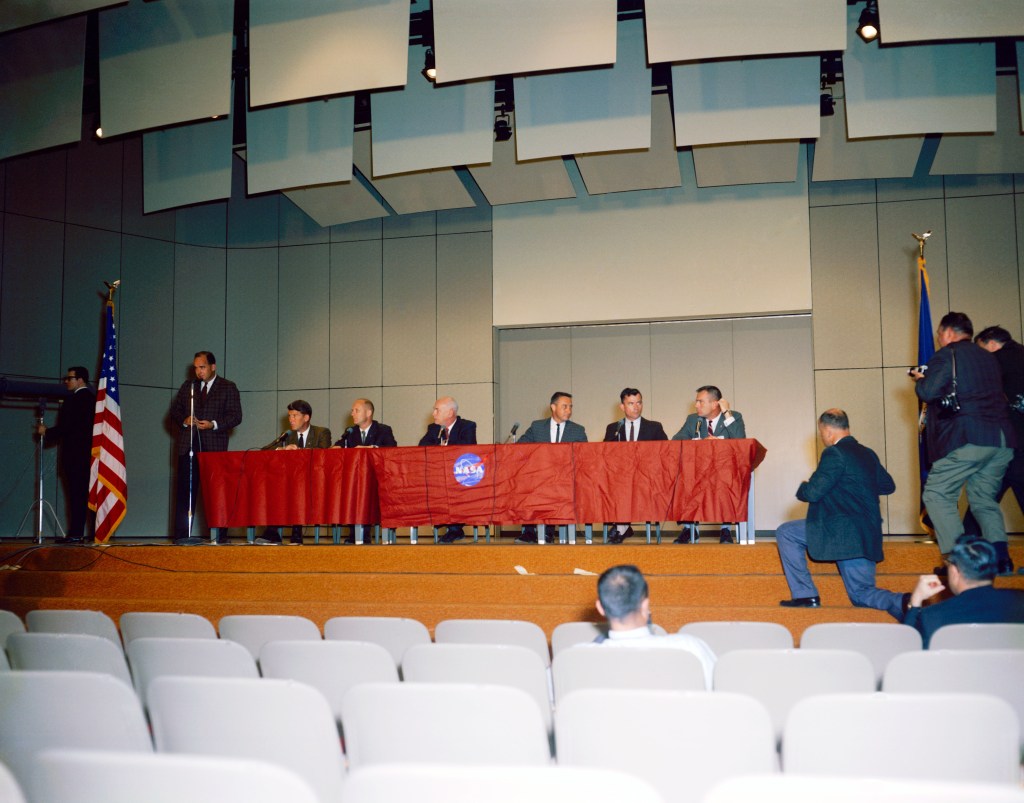The SpaceX Falcon 9 rocket carrying the Dragon spacecraft lifts off from Launch Complex 39A at NASA’s Kennedy Space Center in Florida on Nov. 4, 2024, on the company’s 31st commercial resupply services mission for the agency to the International Space Station. Credit: SpaceX Media accreditation is open for the next launch to deliver NASA science investigations, supplies, and equipment to the International Space Station. NASA and SpaceX are targeting no earlier than Monday, April 21, to launch the SpaceX Dragon spacecraft on the company’s Falcon 9 rocket from Launch…
Read MoreTag: Johnson Space Center
60 Years Ago: Gemini III, America’s First Two-Person Flight
On March 23, 1965, the United States launched the Gemini III spacecraft with astronauts Virgil “Gus” Grissom and John Young aboard, America’s first two-person spaceflight. Grissom earned the honor as the first person to enter space twice and Young as the first member of the second group of astronauts to fly in space. During their three-orbit flight they carried out the first orbital maneuvers of a crewed spacecraft, a critical step toward demonstrating rendezvous and docking. Grissom and Young brought Gemini 3 to a safe splashdown in the Atlantic Ocean.…
Read MoreNASA to Cover Northrop Grumman’s 21st Cargo Space Station Departure
Northrop Grumman’s Cygnus spacecraft is pictured in the grips of the Canadarm2 robotic arm shortly after its capture Credit: NASA After delivering more than 8,200 pounds of supplies, scientific investigations, commercial products, hardware, and other cargo to the orbiting laboratory for NASA and its international partners, Northrop Grumman’s uncrewed Cygnus spacecraft is scheduled to depart the International Space Station on Friday, March 28. Watch NASA’s live coverage of undocking and departure at 6:30 a.m. EDT on NASA+. Learn how to watch NASA content through a variety of platforms, including social…
Read MoreNASA Science Continues After Firefly’s First Moon Mission Concludes
After delivering ten NASA science and technology payloads to the near side of the Moon through NASA’s CLPS (Commercial Lunar Payload Services) initiative and Artemis campaign, Firefly Aerospace’s Blue Ghost Mission 1 lander captured this image of a sunset from the lunar surface. Credit: Firefly Aerospace After landing on the Moon with NASA science and technology demonstrations March 2, Firefly Aerospace’s Blue Ghost Mission 1 concluded its mission March 16. Analysis of data returned to Earth from the NASA instruments continues, benefitting future lunar missions. As part of NASA’s CLPS…
Read MoreTexas High School Aerospace Scholars: A Launchpad for Future Innovators
NASA’s Office of STEM Engagement at Johnson Space Center offers Texas high school students a unique gateway to the world of space exploration through the High School Aerospace Scholars (HAS) program. This initiative gives juniors hands-on experience, working on projects that range from designing spacecraft to planning Mars missions. Nearly 30 participants who have been hired by NASA in the past five years are HAS alumni. Their stories highlight the program’s impact on students—inspiring innovation, fostering collaboration, unlocking their potential as they move forward into STEM careers. Discover how the…
Read MoreNASA Space Day to Share Progress, Opportunities at Texas Capitol
LOCATION: Texas State Capitol – Austin, Texas SUBJECT: Space Day activities at the Texas State Capitol in Austin, Texas PHOTOGRAPHER: Lauren Harnett NASA March 17, 2025 NASA is heading back to the state capitol in March for Space Day Texas, a recognition of achievements throughout Texas and a look ahead to the impact future human space exploration has on the Lone Star state. The two-day schedule of events and exhibits focusing on exploration, astronauts, and science, technology, engineering, and math education will include astronaut visits, interactive exhibits, and legislative proclamations.…
Read More40 Years Ago: Space Shuttle Atlantis Makes its Public Debut
On March 6, 1985, NASA’s newest space shuttle, Atlantis, made its public debut during a rollout ceremony at the Rockwell International manufacturing plant in Palmdale, California. Under construction for three years, Atlantis joined NASA’s other three space-worthy orbiters, Columbia, Challenger, and Discovery, and atmospheric test vehicle Enterprise. Officials from NASA, Rockwell, and other organizations attended the rollout ceremony. By the time NASA retired Atlantis in 2011, it had flown 33 missions in a career spanning 26 years and flying many types of missions envisioned for the space shuttle. The Visitor…
Read MoreStation Science Top News: March 7, 2025
Challenges to measuring space-induced brain changes CSA (Canadian Space Agency) astronaut David Saint-Jacques undergoes an MRI for Wayfinding. CSA Researchers found that an upward shift in the brain during spaceflight makes it hard to distinguish different types of tissue, causing errors in determining changes in brain volume. Previous studies have interpreted these changes as evidence of adaptation to space. This finding suggests that unique methods are needed to analyze astronaut brain structure. Wayfinding, a CSA (Canadian Space Agency) investigation, looked at how the brain adapts to space and readapts after…
Read MoreNASA Invites Creators to Design Mascot for Artemis Moon Mission
Credit: NASA NASA is seeking design ideas from global creators for a zero gravity indicator that will fly aboard the agency’s Artemis II test flight. Zero gravity indicators are small, plush items carried aboard spacecraft to provide a visual indication of when the spacecraft and its crew reach space. This opportunity, with a submission deadline of May 27, asks for original designs representing the significance of NASA’s Artemis campaign, the mission, or exploration and discovery, and meet specific requirements for materials and size. “What better way to fly a mission…
Read MoreNASA Sets Coverage for Agency’s SpaceX Crew-10 Launch, Docking
The crew of NASA’s SpaceX Crew-10 mission pictured during an equipment test at the agency’s Kennedy Space Center in Florida. Credit: SpaceX Editor’s Note: This advisory was updated March 5, 2025, to correct that media may ask questions by phone only during the mission overview teleconference. NASA will provide coverage of the upcoming prelaunch and launch activities for the agency’s SpaceX Crew-10 mission to the International Space Station. Liftoff is targeted for 7:48 p.m. EDT, Wednesday, March 12, from Launch Complex 39A at NASA’s Kennedy Space Center in Florida. The…
Read More







